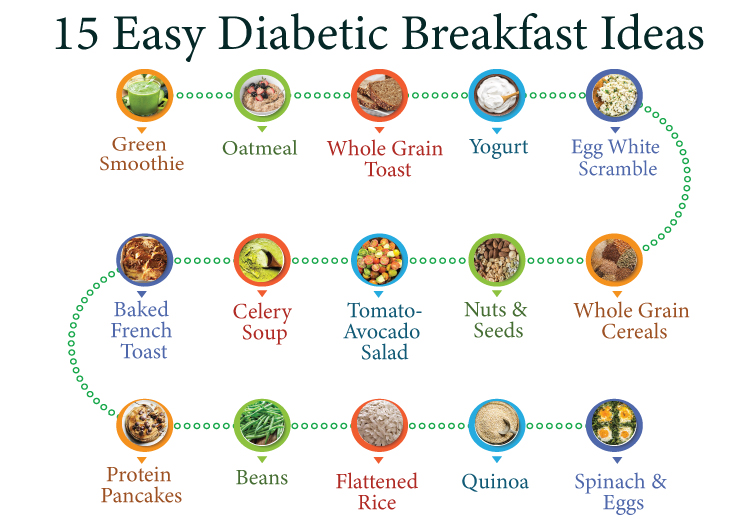Importance of Breakfast for Diabetics
Neglecting breakfast can significantly affect your blood sugar levels. Eating breakfast helps to stabilize your insulin levels, curb your appetite, and fuel your body for the rest of the day.
So here are three excellent reasons to start your day with a good breakfast if you have diabetes:
- A nutritious breakfast can help control blood sugar levels throughout the day.
- Breakfast provides the body with the energy and nutrients it needs to start the day.
- Eating breakfast can help prevent diabetes-related health complications.
Now that you know the importance of a healthy diabetic breakfast, we hope you will never skip this meal of the day.
What is a Good Breakfast for a Diabetic?
A good breakfast for a diabetic must be nutritious and should not spike the blood glucose level. However, there is a misconception that diabetic breakfast is limited in options. One can eat a wide variety of breakfast foods and even follow particular diets for meals. Eating protein-rich but low-carb foods help people with diabetes feel better after eating.
15 Easy Diabetic-Friendly Breakfast Ideas
So if you're trying to manage diabetes or are simply looking for an easy way to start eating healthier – try these 15 easy-to-make diabetic breakfast ideas!

1. Green Smoothie
Green smoothies are nourishing, energizing, and very delicious too. It helps you lose weight, lower cholesterol levels, reduce inflammation, and detoxify your body. A green smoothie has leafy greens, fruits, and nuts. Pt them all in a blender and blend until smooth. Add ice cubes and honey to make it taste cold and sweet.
2. Oatmeal
Oatmeal is a simple breakfast for diabetics with type 2. It is full of fiber, protein, and vitamins. It helps reduce cholesterol, prevent heart disease, and also lower the risk of diabetes. There are two types of oatmeal: rolled oats and steel-cut oats. Steel-cut oats give a chewier texture than rolled oats. By the way, both are delicious!
Simply cook oatmeal according to package instructions. Stir in chopped berries, banana slices, or sliced apples. Top with ground flaxseeds and honey for added nutrition.
3. Whole Grain Toast
Whole grain toast is an excellent choice for a healthy diabetic breakfast. It contains more fiber and nutrients than white bread. Because of the slower release of glucose from whole grains, your blood sugar remains steady throughout the day.
If you prefer something savory, try adding avocado, tomato, and onion. You can also spice the flavor up by sprinkling fresh basil over the top.
4. Yogurt
Yogurt is an instant but very healthy breakfast for diabetics. It contains probiotics which help maintain a healthy digestive system. Probiotic bacteria are suitable for the immune system. In addition, Yogurt helps lower cholesterol levels and fights obesity.
Yogurt is rich in protein, calcium, and vitamin D. If you don't eat dairy products, try using nonfat Greek Yogurt instead. Add some fresh fruit on top for extra flavor. You can also use frozen berries. Frozen fruits tend to retain their nutritional value longer than fresh ones.
5. Egg White Scramble
Egg whites have fewer calories, making them a healthy diabetic breakfast option. Mix four egg whites with two teaspoons of water and season with salt, pepper, and garlic powder. Cook for five minutes and eat with Guacamole salsa dip for added flavor.
6. Baked French Toast
Baked french Toast is the perfect breakfast option. Cut bread into thick slices and dip each slice in a mixture of beaten eggs and milk. Wrap in foil and bake for 15 to 20 minutes. Sprinkle with powdered sugar and serve warm.
7. Tomato-Avocado Salad
Tomato-Avocado Salad is low-carb, making it one of the best breakfasts for diabetics. Avocados are high in monounsaturated fats and vitamin E, while tomatoes are rich in lycopene, vitamin C, folate, and dietary fiber.
To make this salad:
● Slice some ripe tomatoes and place them in a bowl.
● Add sliced avocado, chopped basil, red onion, olive oil, balsamic vinegar, salt, pepper, and fresh ground black pepper.
● Mix well and serve immediately.
8. Celery Soup
Celery is a good choice for diabetics because it is low in calories and sugar while high in fiber. Another reason why celery is suitable for people with diabetes is that it is rich in vitamin K. Vitamin K content reduces inflammation and improves insulin sensitivity and glucose metabolism.
To make celery soup:
● Chop up a bunch of celery and cook it in a pot of boiling water for about 10 minutes or until tender.
● Drain the celery and discard the cooking liquid.
● Add salt, pepper, and butter to taste.
● Enjoy while it is still hot.
9. Whole Grain Cereals
A quick and nutritious diabetic breakfast recipe: Whole grain cereals are packed with fiber, vitamins, and minerals. Try whole wheat cereal with milk or soy milk. Top with fresh fruit, honey, or nut butter.
10. Nuts and Seeds
Nuts and seeds are an excellent breakfast snack option. Try almond butter, sunflower seed butter, peanut butter, cashews, pumpkin seeds, sesame seeds, flaxseeds, chia seeds, and hemp seeds. These foods are rich in omega-fatty acids, which lower bad cholesterol and prevent heart disease.
11. Beans
Beans are loaded with fiber, folate, and protein. Black beans contain a type of soluble fiber called pectin that aids in lowering bad cholesterol. Pinto beans are higher in protein than black beans. Kidney beans are higher in fiber and lower in sodium than other beans.
12. Protein Pancakes
These are ideal for diabetics who wish to maintain their blood sugar levels while still having sufficient protein in their diet. The nice thing about protein cakes is that they only require a small intake. With sufficient protein in the morning, you stay full and energetic all day.
13. Flattened Rice or Poha (Indian Flat Bread)
This is a staple breakfast item in India. It's high in fiber content and low in calories. It contains no fats or cholesterol and is made out of whole grains. It is rich in carbs and protein, making it an excellent substitute for bread and pasta. You may find flattened rice at Indian grocery stores or order them online.
14. Quinoa
Quinoa is the #1 "superfood" since it contains more protein than any other grain. It is a gluten-free grain that's high in protein and fiber. It contains lysine, an amino acid that helps maintain blood sugar levels. In addition, quinoa's high content of iron and folate (vitamin B9) may help prevent diabetes.
15. Spinach and Eggs
No healthier way to start your morning if you have diabetes! You start your day with a meal that will help keep your blood sugar levels steady while providing extra fiber and nutrition.

What can Diabetics Eat for Breakfast, Lunch, and Dinner?
The first step in managing diabetes is to control what goes into the mouth. Eating foods high in simple carbohydrates and refined grains increases blood sugar levels and contributes to poor blood sugar management. If you want to avoid eating these foods, try choosing healthier options.
● Breakfast
A good breakfast should provide complex carbohydrates, fiber, lean protein, and low-fat dairy products. A bowl of fruits and oatmeal is ideal for the day. French Toast, scrambled eggs, and whole wheat toast with almond or peanut butter are further other alternatives.
● Lunch
Choose a sandwich with whole grain bread, pasta, brown rice, or baked potato for lunch. Add avocado or hummus for added nutrition. Lean meat, poultry, fish, or seafood make great lunchtime choices. Try adding vegetables to any meal for extra nutritional value.
● Dinner
Dinner should consist of a salad or veggie dish, starch, and lean protein. Veggies can be steamed, grilled, roasted, or sauteed. Grains such as quinoa, couscous, barley, oats, and wild rice add fiber and protein to meals. Protein can also be added to meals in the form of chicken, tofu, fish, shrimp, scallops, and salmon.
Healthy Eating Habits for Diabetic People
High blood sugar levels can cause organ damage and lead to severe complications. People with diabetes must follow specific diet plans to control their blood sugar levels and prevent severe complications.
These diets should include foods rich in fiber, complex carbohydrates, protein, vitamins and minerals. Here are some tips you can follow:
1. Eat Fruits and Vegetables
They are high in fiber but low in calories. They help control blood sugar levels while providing vitamins and minerals.
2. Cut Down on Fats
Reducing fat intake lowers cholesterol and triglyceride levels. Use olive oil instead of butter. Limit fried foods and avoid processed snack foods.
3. Drink Plenty of Water
Try Drinking eight glasses of water daily. It keeps your body well hydrated, which helps reduce hunger cravings. Water also flushes out toxins and helps regulate insulin levels.
4. Get Active
Exercise regularly. It is an excellent way to keep your blood glucose level under control. A simple activity, such as walking, swimming, cycling, and jogging, burns extra calories and raises your metabolic rate.
5. Don't Ignore Your Doctor
Finally, don't ignore regular health checkups. Your doctor can advise you better on managing the condition and suggest vital changes to your diet depending on your current health status.
Final Words
Diabetes affects about 5% of Americans over age 20. That means 25 million people in the United States have diabetes. Globally, nearly 415 Million people are living with diabetes.
Whether you are diabetic, non-diabetic, or pre-diabetic, we hope now you know how to make a diabetic-friendly breakfast. Additionally, keep an eye on the portion sizes.
Even if it is a healthy diabetic breakfast, overeating will increase the total calories, sharply raising blood sugar levels. You can prevent consuming too many calories and carbohydrates using carb counting.
Talk to your doctor or an experienced nutritionist if you have any questions about a specific food or need assistance figuring out the right hand-measures for the ideal portion size.



 Contact Us
Contact Us







 Hospitals
Hospitals
 Doctors
Doctors
 Diagnostic
Diagnostic
 Pharmacy
Pharmacy
 Health Tips
Health Tips
 Blog
Blog



















Comments